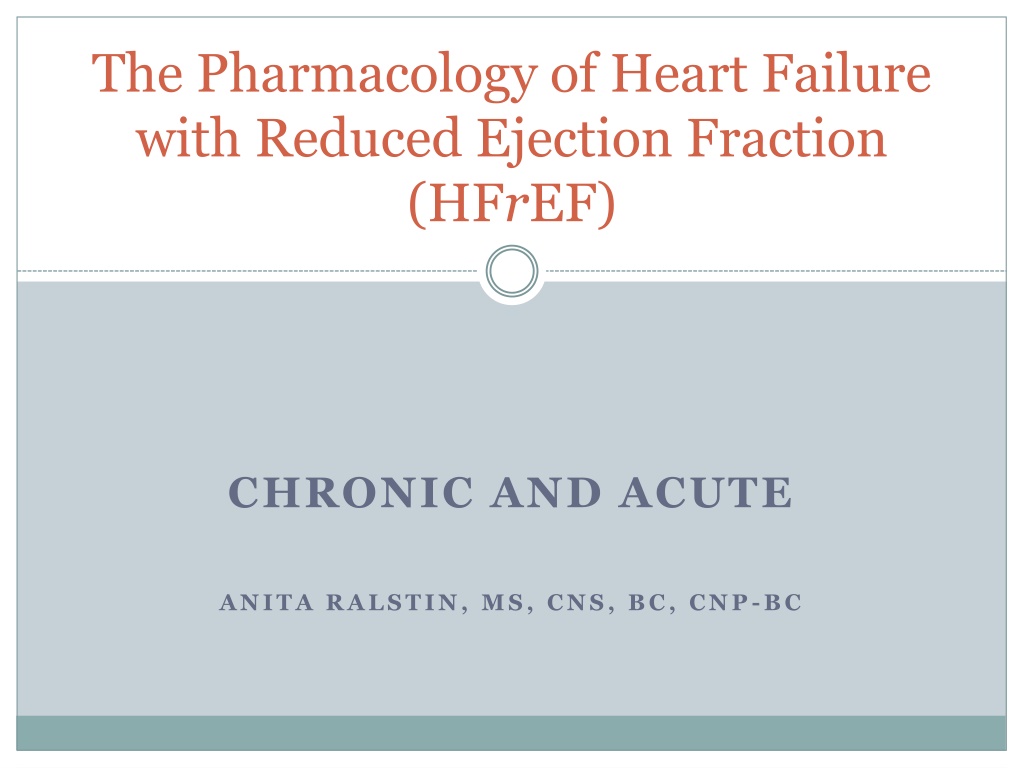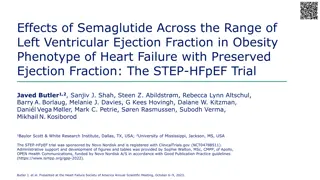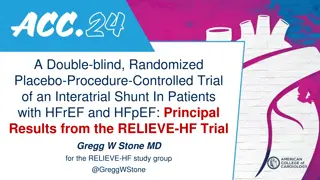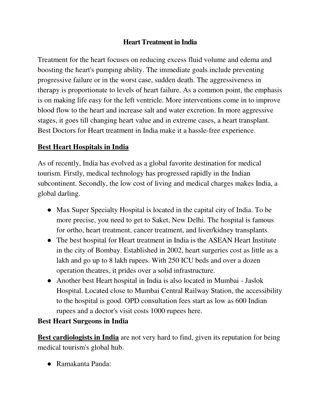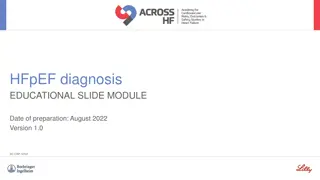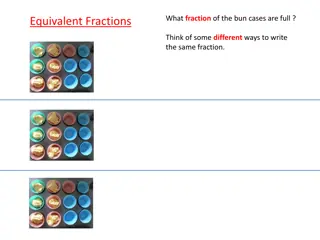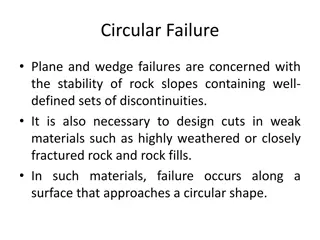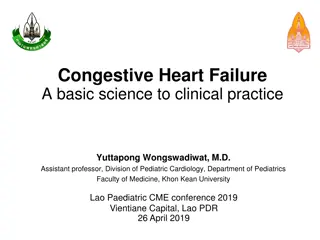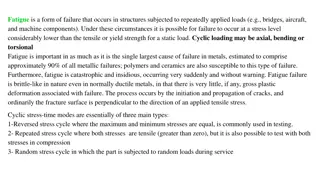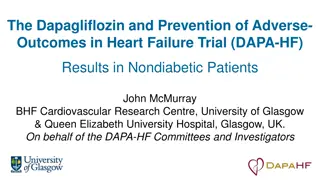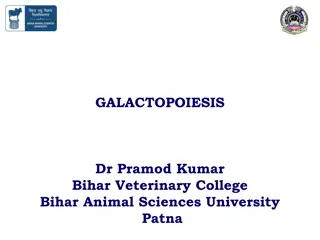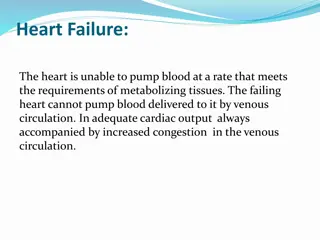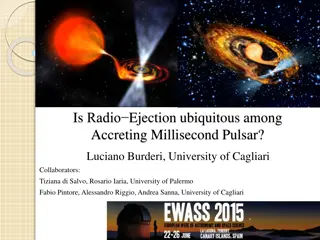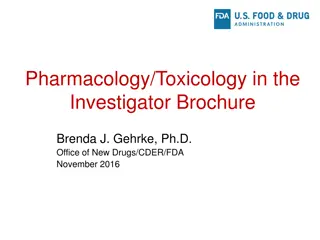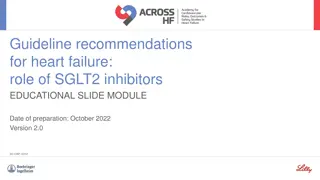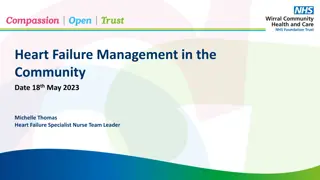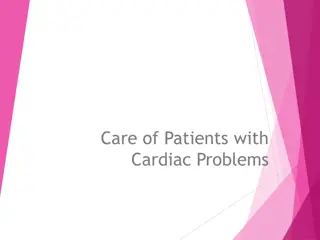Pharmacology of Heart Failure with Reduced Ejection Fraction (HFrEF)
Understanding the pharmacology of heart failure with reduced ejection fraction is crucial as it impacts millions of Americans and poses significant healthcare costs. The complex pathophysiology involves mechanisms like the Frank-Starling mechanism, alterations in myocyte regeneration, neurohumoral system activation, and more. Classification of HF includes NYHA classes and ACC/AHA stages. Pharmacological interventions in Stage A and B focus on prevention, hypertension management, CAD prevention, and initiating specific therapies to prevent the progression of heart failure.
Download Presentation

Please find below an Image/Link to download the presentation.
The content on the website is provided AS IS for your information and personal use only. It may not be sold, licensed, or shared on other websites without obtaining consent from the author. Download presentation by click this link. If you encounter any issues during the download, it is possible that the publisher has removed the file from their server.
E N D
Presentation Transcript
The Pharmacology of Heart Failure with Reduced Ejection Fraction (HFrEF) CHRONIC AND ACUTE ANITA RALSTIN, MS, CNS, BC, CNP-BC
HFrEF vs HFpEF Left ventricular failure with reduced EF is now noted as HFrEF (heart failure with reduce ejection fraction) Previous diastolic heart failure is now noted as HFpEF (heart failure with preserved ejection fraction)
Impact of Heart Failure (HF) Approximately 4.6 million American are living with heart failure. Annual number diagnosed: 450,000 Mortality: decreasing, but remains high Researchers predict > 8 million by 2030 2012 direct cost for HF was $20.9 billion, projected to be $53 billion by 2030 Heart Failure Society of America; www.hfsa.org ; K. Fitch, P Pelizzari, B Pyenson; The High Cost of Heart Failure for the Medicare Population: An Actuarial Cost Analysis 2/2015
Complex Pathophysiology of HF The Frank-Starling mechanism, in which an increased preload helps to sustain cardiac performance Alterations in myocyte regeneration and death Myocardial hypertrophy with or without cardiac chamber dilatation, in which the mass of contractile tissue is augmented Activation of neurohumoral system Norepinephrine release Activation of renin-angiotension-aldosterone system Activation of sympathetic nervous system Atrial natruetic peptide, vasopressin
Classification of HF New York Heart Classification I,II,III, IV ACC/AHA Stages Stage A Stage B Stage C Stage D
Stage A Pharmacology Prevention Hypertension management CAD prevention Diabetes management Metabolic syndrome management Treat ETOH abuse
Stage B Pharmacology Developed structural heart disease without symptoms of HF Initiate ACE-I or ARB Initiate Beta Blocker therapy Aldosterone Blocking
ACE-I/ARB Renin-angiotension-aldosterone system (RAAS) activation Compensatory mechanism to maintain cardiac output Increasing evidence of local RAAS at the tissue level (heart, kidney and vasculature) Angiotension II is a potent vasoconstrictor, triggers SNS and adrenal release of aldosterone Ace Inhibitors were found to improve survival in CHF patients Delay onset & progression of HF in pts with asymptomatic LV dysfunction cardiac remodeling
Common ACE-I benazepril (Lotensin) captopril (Capoten) enalapril (Vasotec, Epaned) fosinopril (Monopril) lisinopril (Prinivil, Zestril) moexipril (Univasc) perindopril (Aceon) quinapril (Accupril) ramipril (Altace) trandolapril (Mavik)
ACE-I Side Effects Angioedema Hypotension Renal insufficiency Rash Cough Monitor renal function and potassium levels
ARB Considered equivalent to ACE-I Less cough due to reduced bradykinin release. Minimal evidence supporting using ACE-I and ARB together.
Common ARBs Azilsartan (Edarbi) Candesartan (Atacand) Eprosartan Irbesartan (Avapro) Losartan (Cozaar) Olmesartan (Benicar) Telmisartan (Micardis) Valsartan (Diovan)
ARB Side Effects Less cough than ACE-I Similar SE profile as ACE-I
Beta Blockers (BB) Reduce the effect of the sympathetic nervous system (beta receptors) Reduce heart rate to allow improved left ventricular filling Some relax blood vessels to reduce afterload. Start with ACE-I/ARB as there is a synergic effect Start with low doses and advance.
Approved BB for Heart Failure Carvedilol Bisoprolol Metoprolol XL These have shown to slow progression of HF, prolong survival and reduce ventricular arrhythmias
Side Effects of BB Feeling fatigued Hypotension Bradycardia Cold hands/feet Worsening asthma s/s Hair loss
Stage C Heart Failure Structural changes with s/s of heart failure Continue use of approved BB and ACE-I/ARB Add aldosterone blocking agent Replace ACE-I/ARB with valsartan/sacubitril (Entresto) Consider ivabradine (Corlanor)
Aldosterone Blockade Aldosterone has been shown to cause coronary inflammation, cardiac hypertrophy, myocardial fibrosis, ventricular arrhythmias, and ischemic lesions. Two medications spironolactone eplerenone Indicated for those with EF 35% or less. Stage B or C. Do not use if CR 2.5 in men or 2.0 in women or potassium 5.0 or higher. Stop potassium supplementation, monitor and restart if needed.
spironolactone Non-selective blocker leads to increased incidence of gynecomastia, Dose 12.5 to 25 mg daily. May reduce dose to QOD for GFR 30-49. Monitor renal function and potassium levels at onset and 1 week post implementation, then monthly for first 3 moths.
eplerenone Considered to be as potent as spironolactone. Dose 25 mg daily. May reduce dose to QOD for GFR 30-49. Monitor renal function and potassium levels at onset and 1 week post implementation, then monthly for first 3 moths.
Valsartan/sacubitril ARB (valsartan) is combined with an inhibitor of neprilysin, an enzyme that degrades natriuretic peptides, bradykinin, adreno-medullin, and other vasoactive peptides. In an RCT that compared the first approved ARNI, valsartan/sacubitril, with enalapril in symptomatic patients with HFrEF tolerating an adequate dose of either ACE inhibitor or ARB, the ARNI reduced the composite endpoint of cardiovascular death or HF hospitalization significantly, by 20% C. Yancy, et.al: 2016 ACC/AHA/HFSA Guideline for the Management of Heart Failure
Valsartan/sacubitril On ACE-I/ARB Allow 36 hour washout Start at 49/51 BID dose Not on ACE-I/ARB or severe renal impairment Start at 24/26 BID Increase every 2-4 weeks to target maintenance dose of 97/103 BID
Side Effects valsartan/sacubitril Hypotension Impaired renal function Angioedema Hyperkalemia Cost $12.50/day; $4500/year
ivabradine (Corlanor) Indications: heart rate reduction Corlanor (ivabradine) is a hyperpolarization- activated cyclic nucleotide-gated channel blocker indicated to reduce the risk of hospitalization for worsening heart failure in patients with stable, symptomatic chronic heart failure with left ventricular ejection fraction 35%, who are in sinus rhythm with resting heart rate 70 beats per minute and either are on maximally tolerated doses of beta- blockers or have a contraindication to beta-blocker use Corlaor Prescribing Information 1/2017
ivabradine (Corlanor) Up titrate BB first. For patients on maximum tolerated medical therapy with sinus rhythm and resting heart rate > 70 BPM. Initiate at 5 mg BID, assess at 2 weeks and up titrate to 7.5 mg BID to maintain resting HR between 50-60 BPM Reduce dose to 2.5 mg BID or stop medication if resting HR < 50 BPM
ivabradine (Corlanor) Contraindications Acute decompensated HF BP < 90/50 SSS, AV Block unless pacemaker in place Sinus bradycardia Use with strong CYP3A4 inhibitors -incomplete list Alprazolam, carbamazepine, colchicine, cyclosporine, dexamethasone, disopyramide, fluticasone, lovastatin, repaglinide, sildenafil, simvastatin, tadalafil, triazolam
ivabradine (Corlanor) Side Effects Fetal toxicity Atrial fibrillation Bradycardia and conduction disturbances Syncope Ventricular arrhythmias Cost About $375/month
Diuretics Used for fluid volume management Use lifestyle changes to reduce the dependence on diuretics. Loop diuretics are most effective. furosemide torsemide bumetanide
Pearls for Diuretics If loosing effectiveness, switch to another loop for a time Add metolazone 2.5 to 5 mg PO 30 minutes before diuretic dose. Educate the patient on s/s of dehydration Prescribe just a few tablets Monitor and replace potassium and magnesium.
Digoxin May be considered in HF patients to reduce hospitalization. Narrow therapeutic window Toxicity Anorexia Nausea, vomiting Headache Disorientation.
Vasodilators Reduction of afterload by arteriolar vasodilatation (hydralazine) reduce LVEDP, O2 consumption, improve myocardial perfusion, stroke volume and COP Reduction of preload Byvenous dilation (nitrate) the venous return the load on both ventricles. Usually the maximum benefit is achieved by using agents with both action. Use when intolerant to ACE-I/ARB.
Vasodilators Monitor BP and renal function. Headache common SE of nitrates and hydralazine. Hydralazine also can cause nausea, vomiting, diarrhea and orthostatic hypotension.
Stage D End stage heart failure Medications continue as long as HR and BP can be sustained. Wean medications when BP cannot be sustained. Consider advanced heart failure therapies or inotropic support.
Acute Decompensated Heart Failure Common and potentially fatal Maintain outpatient HF medications as possible Usually present with acute dyspnea from pulmonary edema Can also present with signs of low output: fatigue, marked exercise intolerance, anorexia, cognitive impairment
Acute Decompensated Heart Failure Treatment Goals Goals Hemodynamic stabilization Support oxygenation and ventilation Symptom relief Modalities Diuresis Supplemental oxygen and assisted ventilation Vasodilator therapy in some patients Inotropes Arrhythmia Management
Diuresis and Vasodilation Mainstays of therapy Flash pulmonary edema with HTN Diuresis and aggressive vasodilation Normotensive and volume overload Diuresis and vasodilation Hypotension and volume overload Diuresis +/- inotropes Aortic Stenosis Diuresis with caution
Diuretics IV preferred over PO because of better bioavailability; bypasses GI congestion Common initial doses: furosemide 40 mg, bumetanide 1 mg, torsemide 10-20 mg Rule of thumb: 1-2.5 times their normal PO dose Peak diuresis is 30 minutes after administration Bolus and continuous IV infusions have similar efficacy Adding a thiazide diuretic (metolazone) can potentiate the effects of the loop diuretics
Vasodilators IV nitroglycerin or IV nitroprusside Monitor BP to make sure hypotension does not develop Nitrates are contraindicated with PDE-5 inhibitors like sildenafil Nitroprusside Don t titrate above 400 mcg/min of nitroprusside (cyanide toxicity) Can result in reflex tachycardia or rebound vasoconstriction
Inotropes Consider if hypotensive with severe systolic dysfunction Can lead to ischemia (increased HR and myocardial oxygen consumption) or arrhythmias Worse mortality if given to patients who do not critically need these meds Dobutamine and dopamine: primarily beta-1 agonists Milrinone: phosphodiesterase inhibitor
Dopamine Dobutamine Can be used at low dose to improve renal blood flow if diuresis is not adequate. For cardiogenic shock, inotropes are used to support sufficient blood flow to preserve organ function. Dopamine to improve cardiac contractility, initiate at 5-10 mcg/kg/min IV Dobutamine has less MVO2 demand, may result in tachycardia. 0.5-1 mcg/kg/min IV
Norepinephrine Catecholamine with alpha receptor activity (vasoconstriction) to treat hypotension Increases afterload which could reduce cardiac output. Increases myocardial oxygen consumption. Dose for acute hypotension Initial 8-12 mcg/min IV and titrate to effect Maintenance 2-4 mcg/min IV
Milrinone A selective phosphodiesterase inhibitor in cardiac and vascular tissue. Positive inotropic and vasodilator effects. Dose 50 mcg/kg loading dose by IV push over 10 minutes then 0.375-0.75 mcg/kg/min. Used in Stage D HF for symptom management as home infusion. Must demonstrate improvement in right heart pressures and symptoms to qualify.
